
E-commerce has seen steady growth for years, but after COVID-19 hit the world, online retails faced both new challenges and possibilities in developing their business. As a year after the start of the pandemic passed, the online sales landscape has changed dramatically. The avoidance of face-to-face contacts, store closures, and numerous coronavirus-related restrictions has forever changed customer behavior patterns. While the economy and society are undergoing a crucial shift, e-commerce merchants need to adjust their business strategy according to the new requirements.
Since more consumers turn to online shopping, digital transformation becomes inevitable for sellers who want to keep their business going and meet new customer demands. By adopting the latest technologies, implementing personalization techniques into the marketing strategy, and switching to more efficient supply chain practices, companies can achieve success in the upcoming years. To help you better understand in which direction to move and which activities to focus on, we’ve compiled a list of emerging e-commerce trends that are changing the business environment in 2021 and are expected to stay for the years to come. By understanding the expectations of a modern buyer and taking appropriate strategic actions a few steps ahead, it is possible to turn crisis times into an opportunity and ensure consistent business growth.

Before diving deep into the e-commerce industry trends, we want to say a few words about the Magento 2 platform, which stays a leader in the e-commerce world and provides merchants, marketers, and developers with numerous opportunities. Magento is a continuously evolving system, and each of its releases brings innovative solutions to the standard sales algorithm. With the recent updates of its second version, the platform ensures stable performance and top-notch functionality. By leveraging the advanced Magento 2 features, e-commerce store owners can deliver unique customer experiences and streamline backend processes.
Being a leader in the e-commerce open source world, Magento 2 also has an extended toolset for larger market players and complex e-commerce sites. While the Open Source edition allows more flexibility and wider opportunities due to integration with third-party modules, Magento 2 Commerce provides solutions that enable businesses to achieve higher scalability and enterprise performance.
For merchants who want to operate their business on Magento 2, we offer an all-in-one import/export solution that can satisfy any needs related to data transfer between different systems. In addition to the Improved Import & Export extension, we have developed several add-ons for seamless integration with CRM, ERP, and other third-party systems. If you are interested in migrating to Magento 2 or need a custom solution for integrating with a backend system, feel free to get in touch with us at our contact center.
Table of contents
How COVID-19 Pandemic Changed E-Commerce
E-commerce was undergoing steady growth over the last decade. The effectiveness of digital marketing, the convenience of online shopping, and the ability to reach out to customers faster have resulted in more merchants shifting their business to ecommerce platforms. The further development of ecommerce ventures is impacted by the COVID-19 pandemic to a large extent. The coronavirus outbreak has forever changed people’s shopping behavior worldwide and forced companies to adjust their sales and marketing strategies in line with the modern challenges.
Due to the global pandemic, e-commerce experiences an accelerated growth like never before. According to the MarketWatch forecast, the industry’s penetration rates that reached 15% in 2020 will come up to 25% by 2025, which makes a 67% increase in 5 years. Over the recent years, e-commerce sales have seen steady growth and are projected to hit a new record in 2021. Statista forecasts claim that global retail e-commerce sales will amount to $4.9 trillion by the end of 2021, which makes up a 265% growth rate within 7 years from 2014.
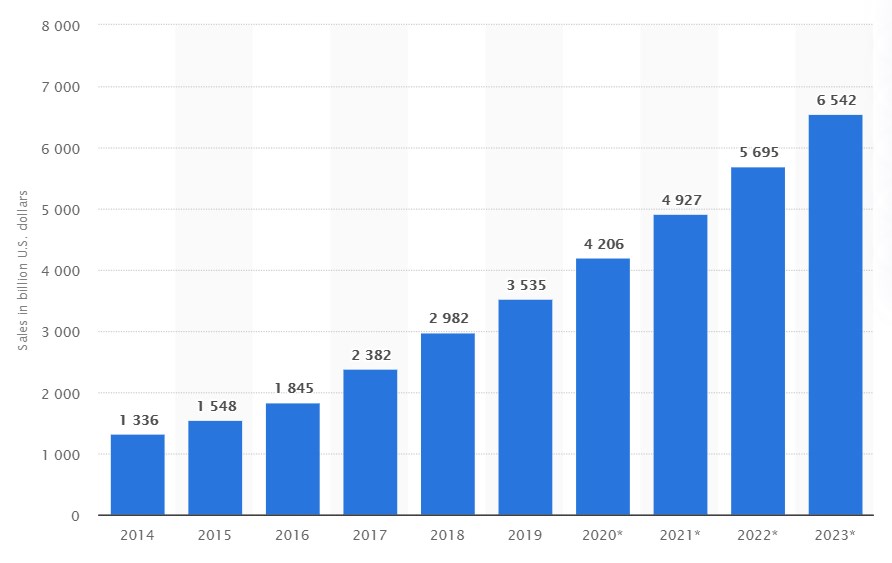
After governments have declared lockdowns in many countries and put restrictions on the operations of physical stores with the view of mitigating the coronavirus outbreak, for many people, online shopping became the only solution for making daily purchases, particularly groceries. The survey conducted by RBC Capital Markets among the US population in March 2020 showed that 42% of 1500 respondents were making their grocery shopping online at least once a week, compared to 22% in 2018.
Experts assume that new buying habits will not disappear after things go back to “normal”, as more customers will get used to the convenience and advantages of online shopping. Such a shift imposes new challenges on retailers but, at the same time, creates numerous possibilities for growth. Merchants who have already invested heavily in e-commerce could already experience expansion.
However, while the COVID-19 pandemic has a positive impact on digital sales, it has an adverse effect on brick-and-mortar stores. Companies that sell apparel, home electronics, homeware, and groceries experience the biggest loss. Since shopping from home is here to stay in the long term, physical stores and malls might face more challenges in the nearest future. That’s why many retail businesses have already turned to online selling, which resulted in a drastic increase in online retail sales in 2020.
Statistics from the eMarketer analysis show a year-over-year increase in the US e-commerce sales by 18% in 2020, which made about 14.5% of total retail sales. The e-commerce sales are projected to reach $765.17 billion in 2021 and get a share of about 14.4% in total retail sales.
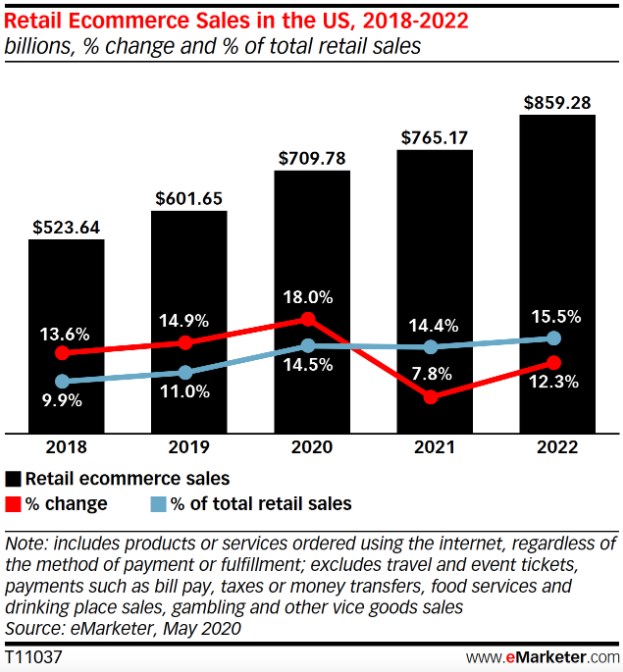
Based on the data collected by Statista, we see that the share of online sales in global retail sales will come up to 17.5% in 2021. In 2019, e-commerce made 14.1% of all retail sales, and its share in the worldwide retail market is expected to reach 22% in 2023. These numbers still represent a small part of the global retail market, meaning that there are many opportunities to grow both for established e-commerce ventures and sellers who want to shift to digital sales.
E-commerce is an ever-changing industry, and last year had an unprecedented impact on customer behavior due to the COVID-19 pandemic. That’s why it is important like never before to look out for the trends following the shift in the economy and society. If you want to stand out from competitors and get more attention to your brand from potential clients, consider taking measures according to the top e-commerce growth trends that we describe further in this article.
Top E-Commerce Growth Trends in 2021 and Beyond
-
Personalization of Customer Buying Journey
E-commerce personalization is one of the most important business growth strategies in 2021 and the following years. Providing customers with a more personalized shopping experience builds loyalty and helps brands to stand out in the rising competition. Showing a personal approach is an effective way to retain existing clients and win the trust of newcomers.
According to research, more than half of customers would spend more for personalization in their buying journey. Besides, almost the same number of shoppers would agree to provide their personal data if they get personal product recommendations and special offers in return. This trend is mostly pushed forward by millennials and younger generations that consider personalized experiences as the top factor for making purchase decisions.
Collecting essential customer information and data analytics is the key to e-commerce personalization. By using Google Analytics and other tracking tools to analyze consumer behavior patterns and interactions with your online site and gathering data from social media platforms, companies can get valuable insights into their potential customers and adjust their marketing strategy to better meet customer demands.
There are several techniques that you can apply to enhance e-commerce personalization. One of the most effective methods for increasing conversions is sending personalized offers and product recommendations based on a customer’s purchase history, browsing behavior, interests, and other personal details. Product recommendations can be delivered to buyers via direct communication or shown as related products in the cart based on purchased items. It is also important to allow customers to choose the preferred communication channels, the information they want to see, and the frequency of updates. One more tactic for increasing personalization is collecting customer feedback after making a purchase, which allows merchants to add social proof to their marketing campaigns.
-
Increase in Mobile E-Commerce Sales
The surge in mobile shopping is another evolving trend in digital commerce. Millennials already adopted the convenience of shopping from their tablets and smartphones, and other generations are joining the trend. Continuous mobile app updates and the ability to make purchases on the go increase customer engagement on mobile. Due to the COVID-19 pandemic, customers feel even more comfortable looking for information about the products or services they want to buy and making purchases from their mobile devices.
According to the data collected by Statista, purchases made via mobile devices will make up almost 73% of all e-commerce sales by the end of 2021. These statistics prove how crucial it is for online merchants to optimize the shopping experience on their websites across all devices if they want to keep up with the current trend.
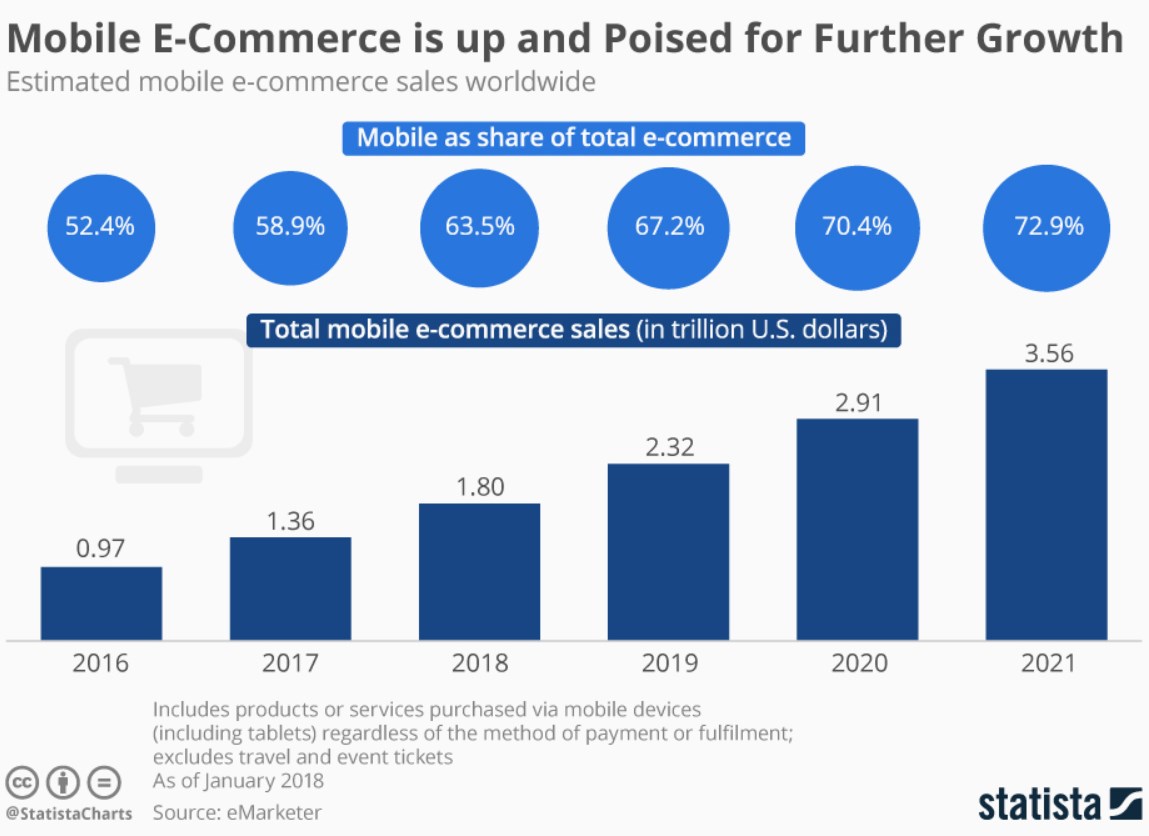
To ensure a seamless user experience on mobile devices, online business owners should test their mobile sites manually to see how pages look on a smartphone or tablet screen and if they are easy to navigate. Another vital aspect of a mobile-friendly website is a smooth and clear checkout process. To get the most out of their marketing efforts, online shop owners might consider building a mobile app if they haven’t developed one yet or implement AMP (accelerated mobile pages) to ensure a smooth user experience across various touchpoints.
Another solution for enhancing mobile UX is creating a progressive web app (PWA). PWAs are based on progressive web technologies and provide online shoppers with a seamless browsing experience and optimized page loading speed. At the same time, progressive web apps are easier to maintain and update compared to mobile applications.
-
The Rise of Voice Commerce
Another e-commerce trend that is picking up is voice technology-based devices and voice search on mobile devices. After Amazon started producing its Alexa Voice Remote and, later, Google introduced Google Assistant, many Internet users turned to voice-based online browsing. According to estimations, 54% of adult people in the US used voice assistants at least once a day in 2020. This number also includes vocal searches on mobile devices, with about 20% of searches performed on Google.
Amazon Echo, Google Home, and other voice assistants gained such popularity due to the increased accuracy and speed of search and constant updates to the technology. Voice commerce will have further growth in 2021 and upcoming years, making it one of the top trends for online merchants to implement in their sales strategy. There are massive updates of local language processing planned for 2021. The voice technology improvements will also be focused on creating an interactive environment that will allow engaging more users. OC&C Strategy Consultants predicts that voice commerce will reach $40 billion in sales, while the number of customers using voice shopping might rise to 50% by 2022.
Optimizing user experience for smart speakers and voice search is critical for online store owners who want to provide customers with advanced shopping possibilities. To make your e-commerce site ready for voice recognition, optimizing website content for voice queries is one of the first things to do. Targeting long-tail queries, incorporating answers to the most common customer questions, and boosting the page load speed are the ways to get more organic traffic from voice searches. With the fact that about 25% of smartphone owners use the vocal search on Google, seamless voice-based website navigation across all devices is also vital for the success of an e-commerce business.
-
Cross-Channel Marketing Campaigns Aligned with New Behavior Patterns
As human behavior patterns change and e-commerce is going through shifts amid the global pandemic, marketing specialists face new challenges in engaging customers. One of the greatest concerns for e-commerce companies is turning one-time buyers into loyal customers. With rising competition in the e-commerce world, attracting customers’ attention and motivating them to make repeat purchases on your store becomes imperative.
One of the most important aspects of effective e-commerce marketing is a comprehensive content strategy. By optimizing your content and making thorough planning of your activities related to publishing and promotion, you can consistently drive traffic to your website and capture the attention of your target audiences. If you focus on the informational needs and interests of your website visitors and deliver the right messages, you can build long-term relationships with your clients and increase their purchase intent.
To increase the efficiency of your marketing efforts, it is important to understand through which touchpoints you can reach out to your target audience and adapt your campaigns to the relevant sales channels. As more and more online shoppers are researching information about the products and services they want to buy online, e-commerce brands need to be easily found on Google, social media, and other places where their potential customers spend most of the time. Since mobile commerce is on the rise, another essential step in your business strategy is optimizing marketing campaigns and social media ads for mobile devices.
Talking about social media marketing, extending your presence on social networks is vital for reaching out to younger generations. According to the data from the survey conducted by Shopify, 67% of consumers from the younger age group (between 18 and 34) are spending more when shopping online compared to the pre-pandemic period. The same survey showed that 54% of customers from the same age group who made a purchase from independent brands found them on social media.
-
Visual Content Plays Bigger Role in the Customer Buying Journey
Making a customer buy a product without seeing it in real life has always been a challenge for e-commerce companies. As the volume of online shopping increases and brands move a bigger part of their activities to e-commerce platforms, customer reviews and product descriptions are not enough to persuade a person to make a purchase. A modern customer wants to see a product in all details before making a purchase decision and do it from their desktop or mobile screen.
Adding standard product photos to your website pages will not help you stand out from the competition. This is when digital marketers turn to visual commerce that includes various types of product imagery. Besides high-resolution images placed across all website pages, visual commerce incorporates user-generated media content, 360-degree images and videos, and augmented reality. By incorporating a visual search tool into your site, you will also increase the chances of your products being found by Internet shoppers who search for products via images.
Incorporating videos in the website content should become a vital part of a successful digital marketing strategy in upcoming years. Videos are highly effective in showcasing products and explaining how to use them, presenting your brand, and educating your audience. According to estimations, an average person’s online video viewing time will amount to 100 minutes per day in 2021, which makes a 19% increase compared to 2019. The rise of video popularity is mostly related to the massive usage of social media applications that constantly update their platforms for adopting video content, like, e.g., Facebook Stories, Instagram Reels, and TikTok viral videos.
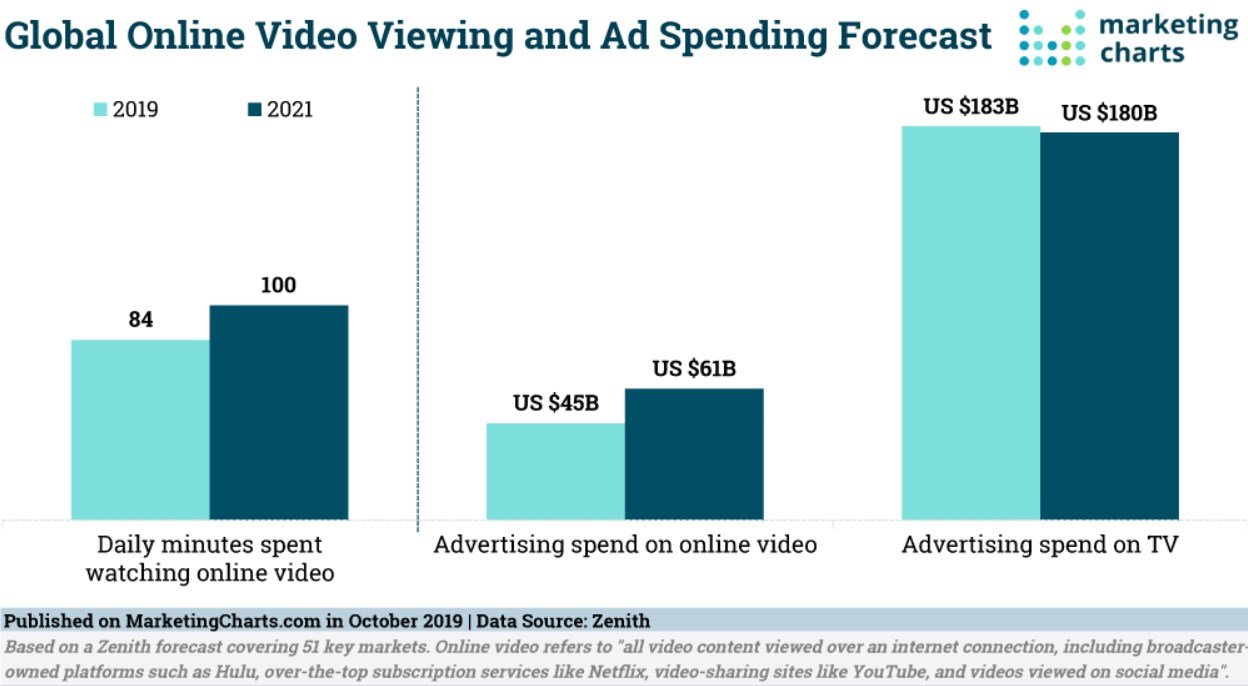
By leveraging visual commerce and increasing online video ad spend, you can create a strong marketing strategy and have impressive results in engaging consumers.
-
Omnichannel Shopping
COVID-19 undoubtedly changed the way consumers prefer to make their purchases, with online shopping surpassing brick-and-mortar sales in the growth rate. However, business owners should always keep in mind that customers’ preferences might differ a lot regarding where and how they are shopping. Even if the pandemic brought more shoppers online, some still like to have in-store interactions or use the click-and-collect option for receiving their orders.
In this regard, it is important for e-commerce brands to be present across multiple platforms. Given the growing popularity of digital sales channels and the increase in mobile devices and voice assistants usage, merchants should consider integrating an omnichannel approach in their marketing strategies. Omnichannel strategy means following customers’ buying journeys across all touchpoints and understanding their engagement with specific marketing channels.
By knowing how and where shoppers interact with one’s brand, sellers can better understand how to allocate their marketing budget and deliver a holistic shopping experience. In addition to running an online or physical shop, e-commerce business owners should turn their attention to mobile commerce and social media channels. To ensure a consistent and personalized user experience across all touchpoints, merchants might use e-commerce solutions like SAP Business One. With this tool, customers can smoothly navigate over a website and mobile UI without losing context.
To optimize your website for mobile devices, you might also consider creating a mobile app or developing a PWA storefront. Another significant part of a successful digital sales strategy is creating brand awareness on social media platforms where your potential clients are more active.
Another way of diversifying sales channels and reaching out to target audiences is being present on an established marketplace, like Amazon, eBay, Etsy, and others. According to the sales statistics of Amazon, more than 50% of all sold items on the platform come from third-party sellers. This direction can be particularly effective for startup businesses and new brands since it helps digital entrepreneurs take advantage of big sellers’ high traffic and a wider choice of shipping options.
-
The Rise of Social Media Commerce and Influencer Marketing
Social commerce is a trend that rapidly gathers pace due to the increasing number of social media users. After Instagram introduced its shopping functionality and Facebook implemented the “Buy” button, social shopping became a significant part of e-commerce activities. Social commerce stands for direct sales via social media, meaning that users can checkout within the app. For example, Instagram allows sellers to place product tags on the posts in their account feed and add product stickers to stories. Upon clicking on the product tag or sticker, customers see a link that can be used for direct purchase.
With other social media platforms, including TikTok, Twitter, Pinterest, and YouTube, introducing the “buy” button, online retailers started including the social selling feature in their marketing strategies. This way, social platforms become a prospective sales channel for brands that want to expand their reach to target audiences, in addition to advertising. While social media is taking more space in people’s daily lives and changing their shopping behavior patterns, companies that widen their exposure to social networks and use creative promotional campaigns ensure their growth in the longer term.
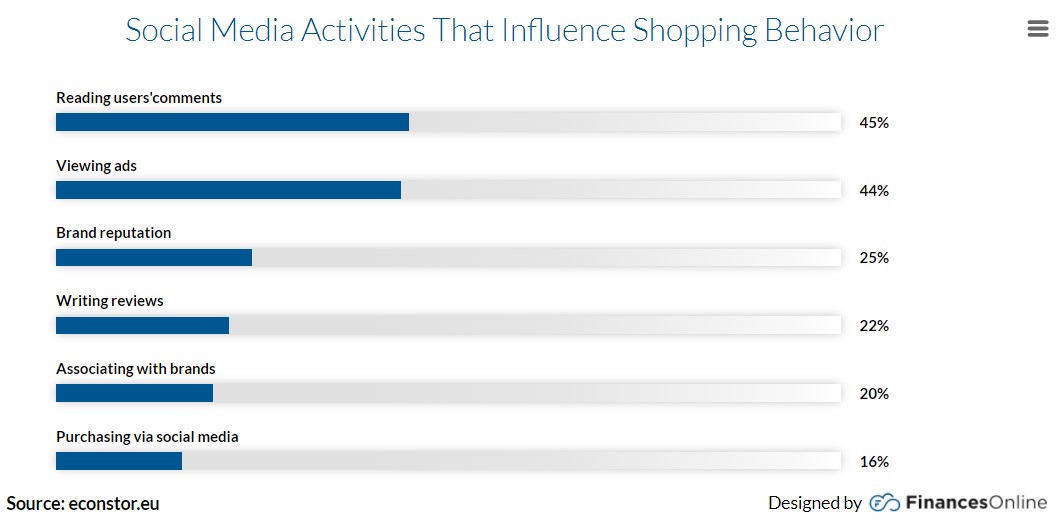
Another way of extending brand exposure on social media channels is establishing partnerships with influencers. Agile businesses have already increased their budget expenditure on influencer marketing, and Instagram is leading this trend. Other platforms widely used for partnering with social media influencers include Facebook and YouTube. According to the stats based on the survey performed by an influencer marketing agency Mediakix, 89% of marketers said that influencer marketing generates ROI comparable to or better than other channels.
Since the growth of the influencer market is not expected to slow down its pace in upcoming years, brands partnering with celebrities and micro-influencers for sponsored social media posts will stay ahead of the game. By focusing on selling products directly on social media combined with celebrity endorsements, businesses can develop more efficient marketing campaigns, driving more sales and conversions.
-
Growth of Augmented and Virtual Reality Market
One of the COVID-19 pandemic implications is the increasing popularity of augmented reality (AR) and virtual reality (VR) technologies. According to the Statista estimation, the sales of AR/VR headsets will double in 2021, with the increase of sold devices from 5.5 million in the previous year to 11 million. As the stats from the same source show, the global AR and VR market size has seen a 79% increase in 2020 0ver 2019.
Since people tend to avoid physical shops and turn to e-commerce stores for making purchases, the ability to explore products in the simulated world offered by virtual reality attracts more customers. As the virtual reality market report by Grand View Research shows, the commercial sector dominated the market in 2020, with a share of over 53%. Businesses from this segment are projected to remain leaders in incorporating AR/VR tech due to many new possibilities across various industries.
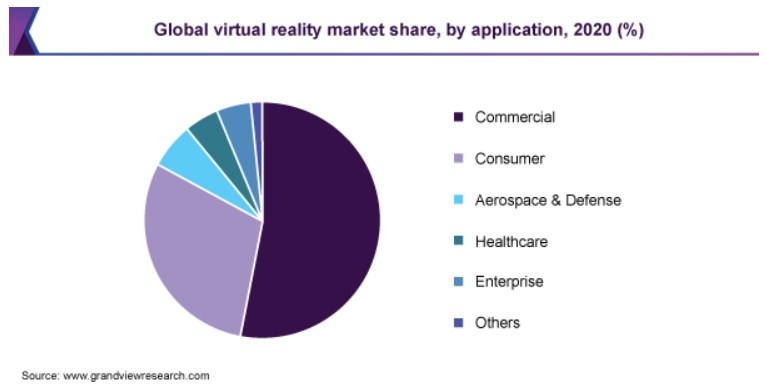
Augmented and virtual reality bridges the gap between the in-store experience and the comfort of online shopping. By implementing VR and AR solutions on an e-commerce site, sellers allow shoppers to visualize products virtually and examine them from different angles, which increases customer engagement and retention. Commercial companies use AR tech to let consumers try out the products before making a purchase decision. That’s why augmented reality solutions find application in the cosmetics and fashion industries. The adoption of VR devices also grows in home furnishings and design, allowing companies to showcase their products in a customer’s real environment.
Besides enhanced digital experiences of online shoppers, e-commerce businesses can leverage AR and VR for marketing campaigns. With these technologies, companies can create interactive product presentations and attract customer attention with creative promotional stunts. Thus, if you want to drive profits and keep up with the growing consumer demands in the upcoming years, incorporating AI and VR solutions is a great way to win customers’ loyalty and increase conversions.
-
AI-Driven Marketing and Customer Service
Artificial intelligence and machine learning help retailers learn more about customers’ interests and provide them with a more personalized approach and product recommendations. Usage of AI solutions will increase in 2021 and upcoming years as the relevant technologies are constantly evolving, and online shoppers demand an in-store-like experience. By implementing AI tools, online sellers can collect vital data about consumers and their shopping behavior and tailor their sales and marketing strategies to better meet customer demands.
According to the study from Juniper Research, retailers will spend $7.3 billion on artificial intelligence by 2022. The data collected by AI tools can be used for marketing purposes and the generation of individualized promo offers. By analyzing shoppers’ behavior patterns based on previous purchases and browsing history, e-commerce merchants can also improve customer services with AI chatbots. Chatbots compensate for the lack of face-to-face customer interactions in online shops. Chatbot platforms provide many benefits to both customers and business owners, from getting replies to basic questions and creating live communication to collecting vital customer data and lead generation automation.
Another promising application of artificial intelligence is content creation, and some of the leading e-commerce retailers already follow this trend. Alibaba released its AI-based copywriting tool a few years ago, allowing merchants to automatically generate product descriptions and even fine-tune their length and tone. Besides automating some routine content creation tasks and product information updates, AI writing robots help websites get higher rankings in the Google search results.
Another beneficial application of AI tech can be found in business processes automation. By incorporating AI assistants in a workflow, companies can manage inventory, warehousing, and fulfillment more efficiently. Retailers also leverage AI tools for improving demand forecasting and pricing.
-
Ethical and Sustainable Business Practices Get More Value
For a modern consumer, sustainability practices in product manufacturing and impact on the environment become more essential factors than pricing when making purchase decisions. This trend is usually called green consumerism and relates to the shift of buying preferences to eco-friendly products and recyclable packaging. When environmentally conscious customers decide from which brand to buy a product, environmental and societal responsibility are among top priorities.
According to the recent IBM report on consumers driving change, 57% of customers are ready to change their buying habits to reduce a negative impact on the environment. The same report shows how customers whose purchase decisions are driven by alignment with their value choose brands. For over 70% of surveyed customers, “clean” products, sustainable and environmentally responsible produce, recycling availability, and organic ingredients are very or moderately important. Moreover, over 70% of purpose-driven consumers are willing to pay more for goods that are sustainable or less harmful to the environment. If looking at the age groups for whom sustainable practices play a bigger role in brand preferences, millennials are major contributors to ethical consumerism.
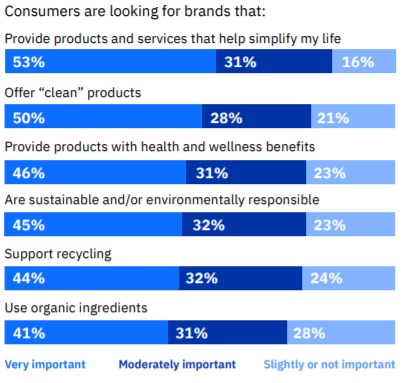
While the consumers’ eco and social consciousness rise, merchants need to take rapid actions to follow the trend and stay competitive. Top e-commerce companies are already implementing sustainable practices to minimize the negative impact on the environment. For example, Amazon has made a commitment to reduce its carbon emissions to zero by 2040.
If you want your brand to find resonance with modern shoppers, make sure to implement environmentally friendly practices in your business strategy. There are many ways to make your business more sustainable and engage “green” customers. Switching to product packaging from recycled or biodegradable materials or substituting plastic with glass are proven solutions to make your business more ec0-friendly. For e-commerce brands, it is also important to ensure customers that they reduce the digital carbon footprint of their online shop or app to the minimum. It can be achieved by moving your hosting to a provider that runs servers on renewable energy and optimizing your website in terms of page loading speed and file size.
-
Emerging Markets are Shaping The Future of E-Commerce
Economies in developing countries have seen substantial growth over the recent years. India, China, Russia, Brazil, and South Africa are among the big emerging markets that are predicted to have a significant impact on the e-commerce industry. According to the data from the Boston Consulting Group report, about 3 million people from emerging markets will use online shopping by 2022. The same report states that by 2022, the share of developing economies in overall digital retail sales will go up to 20%.
After recovering from the latest recession, economies in Latin America have been experiencing substantial growth. As the COVID pandemic hit the region, more consumers went online. According to Statista estimations, retail e-commerce sales in Latin American countries will reach $116 billion by 2023. The number of online shoppers in Asia is also growing rapidly, and e-commerce sales are increasing accordingly. As Statista Digital Market Outlook shows, the number of consumers in the Asian e-commerce market will surpass 3 million by 2025. Asian countries, particularly China and India, are also huge adopters of mobile technology, which makes this market highly competitive.
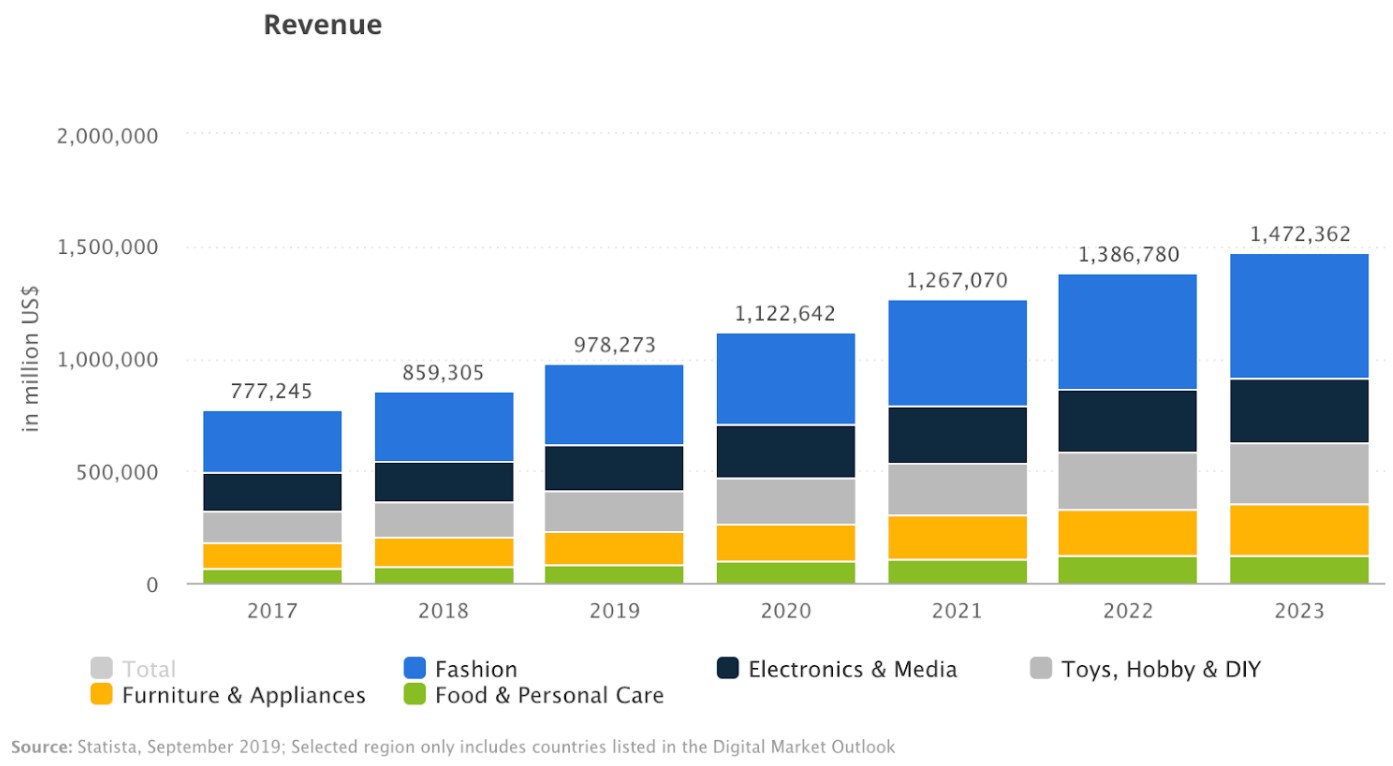
These regions hold a huge potential for companies that want to expand their business and penetrate new markets. However, brands that want to tap into emerging markets should adjust their strategies to the local requirements. It involves offering local payment methods, localizing content across all channels, optimizing shipping and logistics on the country level, and using appropriate communication channels.
Final Words
E-commerce is an ever-changing industry, and the tendencies influenced by the economic and societal transformations in 2021 are shaping its future. The COVID pandemic has a drastic impact on consumer behavior patterns and preferences. By understanding your target audience and adjusting your sales and marketing strategies to the transforming business environment, you can achieve success in the long term.
The described above trends show the main directions of business development in 2021 and the following years. By focusing on meeting customer demands, adopting new technology, and reaching out to potential clients on social media, you will prepare the ground for the stable growth of your business in the future. As buyers feel more confident in the digital space, retailers who can personalize customer journey and deliver an omnichannel experience will have more power and stay ahead of the competitors. In addition to the buyer-centric approach, digitizing business operations and implementing innovative solutions can bring an e-commerce business to a new level and accelerate revenue streams.
E-Commerce Trends FAQ
What are the current trends in e-commerce?
Top e-commerce trends 2021 include the following:
– Accelerated growth of augmented (AR) and virtual (VR) reality.
– The growing popularity of voice search and voice shopping.
– Increase in the application of artificial intelligence (AI) and machine learning for personalizing customer experiences.
– Improvements in customer service with chatbots.
– The growth of mobile e-commerce.
– Wider adoption of headless and API-based commerce.
– Video and interactive content become essential for engaging customers.
– The increasing role of environmental consciousness and sustainability concerns in purchase decisions.
– Social media takes a bigger part in the customer buying journey.
How can I grow my ecommerce business in 2021?
The key to success for an e-commerce business in 2021 is focusing on the needs of your target audience and personalizing their shopping experience. After finding your end consumers and understanding where they spend most of their time, you should ensure maximum convenience of shopping on your store and provide them with excellent customer support. Another essential aspect of a growth-driven business strategy is promoting your brand across various channels.
What is the future of the e-commerce industry?
According to recent forecasts, e-commerce will be experiencing steady growth over the next few years. Its share in global retail sales is projected to reach 22% in 2023. By the end of 2021, e-commerce sales are expected to hit a new record and amount to $4.9 trillion. By 2024, online sales are projected to come up to $6.4 trillion.
How to promote your online brand in 2021?
The best ways to promote your business in 2021, with or without money, are the following:
– Create and optimize your Google Business Profile.
– Create your company website and optimize it for search engines.
– Start a business blog and share your posts.
– Run marketing campaigns on Google Ads.
– Create and optimize listings on the major online directories, including Google, Yelp, Facebook, and others.
– Promote your business on social media.
– Join online communities relevant to your business and contribute.
How to increase sales in 2021?
If you want to increase online sales in 2021, you should focus on building a digital-first business strategy. After the COVID-19 pandemic hit the world and the number of online customers started growing rapidly, digital transformation became essential for both B2B and B2C companies. The digital-first strategy embraces targeted marketing and increases customer engagement across digital sales channels.
What is omnichannel marketing?
The omnichannel stands for the approach that provides customers with a seamless experience across all possible channels and touchpoints. In omnichannel strategy, all marketing efforts aim to provide consumers with a smooth shopping experience no matter which device or sales channel they use.
What is the best strategy for growing the e-commerce business in 2021?
The top priorities for optimizing e-commerce growth strategy include the following actions:
– optimize your website;
– ensure seamless user experience when browsing your online store and at the checkout;
– present your business on marketplaces;
– implement marketing automation tools;
– leverage the power of content marketing;
– embrace social media channels;
– optimize for mobile.
What are the top trends in digital marketing for 2021?
Top digital marketing strategies for online businesses to thrive in 2021:
– implement artificial intelligence (AI) to improve customer services, gather consumer data, and track sales;
– focus on personalized and data-driven marketing;
– optimize content for voice search;
– leverage social media for direct shopping (i.e., shoppable posts) and reaching out to target audience;
– collaborate with influencers to increase your brand exposure;
– create interactive content and video content;
– implement virtual reality (VR) and augmented reality (AR) to provide consumers with in-store-like shopping experiences;
– incorporate chatbots to establish better communication with customers.
What are the biggest content marketing trends for 2021?
The top content marketing trends to watch in 2021 are:
– Focus on value-driven content that shows expertise in the subject.
– Growing adoption of artificial intelligence and machine learning for creating a copy.
– Prioritization of high-quality content that improves overall user experience.
– Importance of interactive content for engaging customers.
– Content atomization.
– Changes in Google algorithm based on Core Web Vitals.
How do you know if a brand is sustainable?
Sustainability implies that products offered by a company are eco-friendly, adhere to social or economic issues, or follow ethical principles in their production. So, first, define to which category a brand that you are doing research about belongs. Then, go to the company’s website, learn about its history and mission, and read through all the available information. Bigger companies mostly have certifications, e.g. Fairtrade or Global Organic Textile Standard. Companies may also provide links to the code of conduct or code of ethics on their websites.







